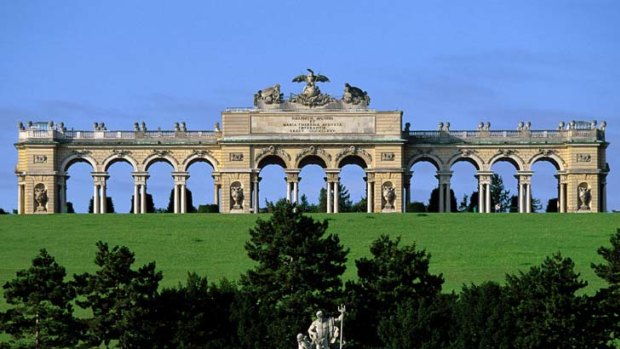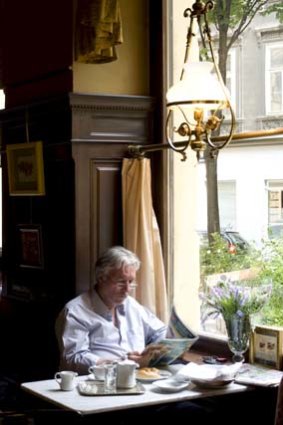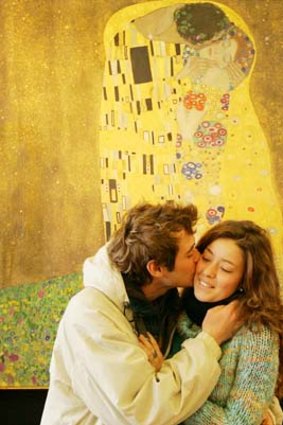
The gardens at Schoenbrunn Palace.Credit: AFP
Vienna is a lavishly sophisticated city for culture, contemplation and cake, writes Michael Gebicki.
WHEN they have a beef, the graffiti artists of Vienna go for gold. So overwhelming is the aura of noble ostentation and refinement cast by the city of the Habsburgs that when they want to shout their angst or their anomie - because Vienna is also the city of Freud, after all - the city's graffitists reach not for Bolshevik black or revolutionary red but the gold spray can.
Vienna is one of the jewels of Europe's cities, as sumptuous as Paris, as lavishly endowed as Barcelona, prettier than Prague. Within the Ringstrasse, the giant boulevard that throws a lasso around the 1.6 square kilometres of the inner city, is a wonderland of Gothic and baroque architecture, crammed with churches with fairytale spires, wedding-cake palaces, cobblestone squares and monumental buildings created when the Habsburg empire was at the height of its powers. This is one city where the tourist agenda comes with an aristocratic flavour.

Contemplating at Sperl Cafe.Credit: AFP
In a single day in Vienna you can lunch on Tafelspitz, "the emperor's dish", while watching the butterflies in a soaring glass art nouveau palmhouse beside the Hofburg Palace, watch the prancing white Lipizzaner stallions of the Spanish Riding School, take a stroll through the imperial gardens at Schoenbrunn Palace and take in a performance by the Vienna Boys Choir in the Musikverein's Brahms Hall, possibly the world's most beautiful chamber concert hall. And at every turn, Vienna dishes up small and delicious moments. Walking along Salesianergasse, head reeling from viewing the crystal in the Lobmeyr shop, I was stopped mid-stride by the sounds of a violinist practising Mozart; the music drifting from a window.
Art is inescapable in Vienna. Chances are that once you've ridden a tram, admired the palace and taken a stroll around St Stephen's Cathedral, you'll find yourself wandering about in the city's art galleries - and what a treasure trove they are. There's the Leopold Museum, based on the pre-eminent private collection of 19th- and 20th-century Austrian art assembled by Rudolf Leopold. In the same location, the Museum Quarter, is the MUMOK, the Museum of Modern Art, with works by Andy Warhol, Jasper Johns, Marcel Duchamp and Yoko Ono's Painting to Hammer a Nail, originally shown in London in 1966.
It was at the pre-opening of the show that Yoko met John Lennon; this painting brought them into contact. A sign invited viewers to hammer in their own nail but since the show wasn't yet open, she wouldn't let him do it - unless he gave her five bob. Lennon said: "I'll give you an imaginary five shillings if you let me hammer in an imaginary nail." And with that, history was made.

A kiss in front of Klimt's The Kiss at the Belvedere Museum.Credit: AFP
There's the MAK, the Museum of Applied Arts, with a miraculous collection of decorative arts from the Wiener Werkstatte, which produced silks, leather goods, enamel, jewellery, postcards, ceramics and hats in the early 1900s, representing some of the finest works of art nouveau. The MAK also has one of the finest museum shops you'll ever see and a large gallery dedicated entirely to chairs, which is sheer torture for the jet-lagged traveller who just wants to flop.
Vienna is not complete without a look at the Belvedere, home to Gustav Klimt's iconic The Kiss, reportedly the world's most expensive painting, worth even more than Klimt's other record-buster, Portrait of Adele Bloch-Bauer, which sold in 2006 for a reported $US135 million.
Happily, there is also gemutlichkeit. Gemutlichkeit means, more or less, sitting around and doing nothing much at all. It's the Viennese version of Italy's la dolce vita. A fondness for gemutlichkeit is part of the Viennese DNA and it finds expression in the city's coffee houses. Vienna has more than 800, a legacy of the 17th-century battles against the Turks.
Just like the pubs of London, Vienna's coffee houses are infinitely varied. It's where the Viennese come to gossip with friends, debate, play chess, agonise over the next few lines in the deconstructionist novel they're writing or simply to sit and read the paper - and no waiter would dare disturb a patron, even hours after his single cup of coffee is drained. You won't escape from Vienna without spending time in a coffee house - and with camaraderie and the buzz of conversation on the menu, all for the price of a cup of coffee, what's not to like?
Complementing the beverages is the cake display. Most Viennese are cake connoisseurs, keen to discuss the merits of the cremeschnitte at the Sperl Cafe. Most famous of all is sachertorte, from the Hotel Sacher, the world's most celebrated chocolate cake, although the hotel has been engaged in a long-running dispute with the Demel Cafe over the ownership of the original recipe. One of the topics at issue is whether it is permissible to add a second layer of marmalade in the middle of the cake as well as under the chocolate icing but such trifles keep lawyers profitably engaged.
Vienna's position at the forefront of European culture stalled almost a century ago when the Habsburg Empire was finally dissected, yet over the past few years its reputation as a great city for the arts has been given a shot in the arm. The impetus comes not so much from the fine arts but from design.
At the vanguard of the movement are Fidel Peugeot and Karl Emilio Pircher, two young, animated and passionate designers whose work segues from graphic design to product design to architecture and corporate exhibition work. Housed in a former coffee house, their Walking Chair Gallery betrays a fresh and playful approach to such contemporary problems as how to remove a bottle cap.
Inside, the gallery is littered with examples of their work, from gestation to finished product. Hanging from the ceiling is a clutch of PET lights, modernist chandeliers assembled from shrunken plastic bottles. Funky and invigorating, their work includes guitars, earrings, notebooks and lipstick-red You May furniture, made to withstand use and abuse in public spaces.
Generous and enthusiastic, Peugeot and Pircher are not designers as backroom boffins at a computer screen but social engineers aiming to reignite social relationships in the strained environment of the modern city. They might even demonstrate the walking chair, a lurching animatronic model that never fails to raise a laugh and is proof that under that serious, old-world exterior, Vienna has a funny bone after all.
The writer travelled courtesy of the Austrian National Tourist Office and Sofitel Luxury Hotels.
Bring the city into your suite
VIENNA'S taste for experiment is underlined with the newly opened Sofitel Vienna Stephansdom, which represents a bold new world that presses all the right buttons for the design-conscious traveller.
On the banks of the Danube Canal with a view across the old city, the hotel eliminates decorative detail, relying instead on bold lighting and the city itself for dramatic effect. In the words of its designer, uber-architect Jean Nouvel, the hotel aims to free the viewer from visual anchor points, fostering a dialogue with the city outside and allowing the imagination to roam free.
The Sofitel's most striking feature is the psychedelic ceiling, pictured, which is inset with giant video panels in the top-floor Le Loft restaurant. Seen from the inside at night, the ceiling reflects a mirror image in the restaurant's huge windows, seeming to hover over the city like the underside of an alien spacecraft. Another feature is the "living wall", a vertical garden with 20,000 plants grafted onto a 600-square-metre wall.
Generous by European standards, guest rooms are open-plan, with vertical and horizontal panels that slide across the windows, allowing the guest to frame their own "picture" of the city below.
Rooms come in three shades only — white, black or grey. In mine — a grey, which make up the majority of the Sofitel's 182 rooms — the only hint of colour is from the pulsing red LED on the flat-screen TV. Reports from one client who spent the night in an all-black suite suggest you'll sleep like a baby — but you might find it hard to find your iPhone.
Klimt's coming to Australia
WORKS by Gustav Klimt and Egon Schiele, two giants of Viennese painting from the early 20th century, will be among the highlights of Vienna: Art & Design, coming to Melbourne's National Gallery of Victoria this year. Between June 18 and October 9, the gallery will show some of the best-known works by these provocative artists, with Portrait of Emilie Floge, Klimt's depiction of his lover, as the pin-up piece.
The exhibition will also feature a sublime collection of decorative arts, including jewellery by Josef Hoffmann and the designs of the Wiener Werkstatte (Vienna Workshop). The Klimts in particular are rarely seen outside Vienna. The NGV was granted the show only because it already possesses a notable collection of Viennese works from the period, bequeathed by the Jewish Gallia family, who escaped with their formidable private collection when they fled the Nazi terror as it spread its tentacles into Vienna in the late 1930s.
Trip notes
Getting there
Austrian Airlines operates daily flights from Australia via Bangkok to Vienna, code-sharing with Thai Airways. The return airfare starts from $2037. 1300 655 727, austrian.com
Staying there
Sofitel Vienna Stephansdom is a smart and stylish newcomer overlooking the inner city from the banks of the Danube Canal. Rates start at $332 a night. +43 1 906 160, sofitel.com.
Hotel Am Stephansplatz might look plain but it has a heart of gold — and a prime location at the very heart of the city. Rooms start at €180 ($240) a night. +43 1 534 050, www.hotelamstephansplatz.at.
Eating there
Do & Co Restaurant on Stephansplatz 12 is a cool, fishbowl restaurant jacked up to eye level with the spires of the cathedral in the main square. +43 1 535 3969, doco.com.
Palmenhaus is a gorgeous space inside a barrel-roofed glasshouse nestled against the Hofburg Palace and overlooking the Burggarten. +43 1 533 1033, palmenhaus.at.
See + do
Music, wine, hiking, river cruises, cycling and shopping are just some of the options available to the visitor to Vienna. austria.info.
Leopold Museum, Museumsplatz 1, adults €11, school-age students €7, open daily 10am-6pm, Thurdays 10am-9pm. +43 1 525 700, leopoldmuseum.org.
MUMOK, Museums Quarter, Museumsplatz 1, adults €9, school-age students €6.50. Reopening on September 9. +43 1 52 500, mumok.at.
MAK, Stubenring 5, adults €7.90, under 19s free, open Tuesdays 10am-midnight, Wednesday to Sunday, 10am-6pm. +43 1 712 8000, mak.at/e/jetzt/f_jetzt.htm.
Belvedere, Prinz-Eugen-Strasse 27, adults €14, students €10, daily 10am-6pm. +43 1 795 570, belvedere.at.
Walking Chair Gallery, Rasumofskygasse 10, Monday to Friday 11am-6pm. +43 1 713 2484, walkingchair.com.
More information
Sign up for the Traveller Deals newsletter
Get exclusive travel deals delivered straight to your inbox. Sign up now.